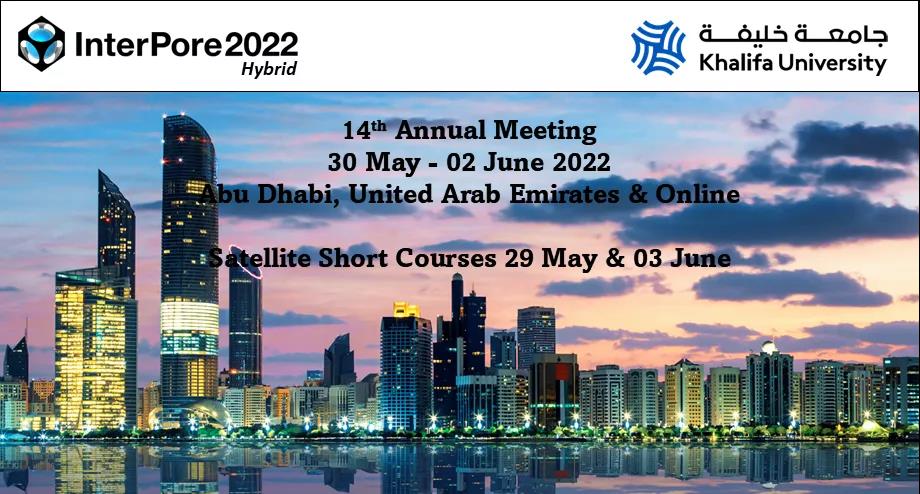Wetting behaviors of water on kerogen surfaces from molecular level: Implication for gas extraction and hydrogen storage in shale
Abstract view|432|times PDF download|115|times
Abstract
Shale formations serve as primary reservoirs for natural gas and emerging candidates for hydrogen storage, where the wetting behaviors of organic matter (i.e., kerogen) play a critical role in fluid retention and transport. This study employed molecular dynamics simulations to investigate the pressure-dependent wettability of kerogen surfaces in H2 and CH4 environments under geological conditions (333 K, 10-100 MPa). Results reveal distinct gas-specific mechanisms governing wettability evolution. For CH4-H2O systems, increasing pressure induces a wettability transition from weakly water-wet to gas-wet due to the strong interaction between CH4 and the kerogen surfaces, which results in a smaller gas-solid interfacial tension compared with liquid-solid interfacial tension . Meanwhile, both the reduced gas-liquid and gas-solid interfacial tension contributes to a linear rise in contact angles (88° to 119°). In contrast, H2 exhibits weaker interactions with the kerogen surfaces and experiences a minimal decrease in gas-liquid interfacial tension, thus presenting persistently water-wet characteristics (53° to 69.5°) even at 100 MPa. Crucially, the Young-Laplace equation remains valid at the nanoscale, as evidenced by direct capillary pressure measurements aligning with theoretical predictions, confirming classical interfacial thermodynamics govern nanoconfined fluid behavior. These mechanistic insights elucidate how gas-specific molecular interactions dictate shale wettability, providing a physicochemical basis for optimizing CH4 recovery through pressure-managed wettability alteration and ensuring H2 storage security in hydrophobic kerogen network.
Document Type: Original article
Cited as: Zhang, M., Huang, J., Wang, H., Niu, W. Wetting behaviors of water on kerogen surfaces from molecular level: Implication for gas extraction and hydrogen storage in shale. Capillarity, 2025, 14(3): 72-81. https://doi.org/10.46690/capi.2025.03.02
Keywords
Full Text:
PDFReferences
Alavi, S., Ripmeester, J., and Klug, D. Molecular - dynamics study of structure II hydrogen clathrates. The Journal of Chemical Physics, 2005, 123(2): 024507.
Alhamad, F., Sedev, R., Ali, M., et al. Effect of methyl orange on the hydrogen wettability of sandstone formation for enhancing the potential of underground hydrogen storage. Energy & Fuels, 2023, 37(8): 6149-6157.
Alinejad, A., and Dehghanpour, H. Evaluating porous media wettability from changes in Helmholtz free energy using spontaneous imbibition profiles. Advances in Water Resources, 2021, 157: 104038.
Al-Yaseri, A., Yekeen, N., Mahmoud, M., et al. Thermodynamic characterization of H2-brine-shale wettability: Implications for hydrogen storage at subsurface. International Journal of Hydrogen Energy, 2022, 47(53): 22510-22521.
Bussi, G., Donadio, D., and Parrinello, M. Canonical sampling through velocity rescaling. The Journal of Chemical Physics, 2007, 126(1): 014101.
Chalmers, G. R., and Bustin, R. M. A multidisciplinary approach in determining the maceral (kerogen type) and mineralogical composition of Upper Cretaceous Eagle Ford Formation: Impact on pore development and pore size distribution. International Journal of Coal Geology, 2017, 171: 93-110.
Chow, Y. F., Maitland, G. C., and Trusler, J. M. Interfacial tensions of (H2O+H2) and (H2O+CO2+H2) systems at temperatures of (298-448) K and pressures up to 45 MPa. Fluid Phase Equilibria, 2018, 475: 37-44.
Essmann, U., Perera, L., Berkowitz, M. L., et al. A smooth particle mesh Ewald method. The Journal of Chemical Physics, 1995, 103(19): 8577-8593.
Hagler, A., Lifson, S., and Dauber, P. Consistent force field studies of intermolecular forces in hydrogen-bonded crystals. 2. A benchmark for the objective comparison of alternative force fields. Journal of the American Chemical Society, 1979, 101(18): 5122-5130.
Hashemi, L., Glerum, W., Farajzadeh, R., et al. Contact angle measurement for hydrogen/brine/sandstone system using captive-bubble method relevant for underground hydrogen storage. Advances in Water Resources, 2021, 154: 103964.
Huang, F., Yang, Y., Kang, S., et al. Microscopic insights into water wetting behaviors and physical origin on α-quartz exposed to varying underground gas species. Chemical Engineering Journal, 2024, 498: 155128.
Huhtamäki, T., Tian, X., Korhonen, J. T., et al. Surface-wetting characterization using contact - angle measurements. Nature Protocols, 2018, 13(7): 1521-1538.
Iglauer, S., Ali, M., and Keshavarz, A. Hydrogen wettability of sandstone reservoirs: Implications for hydrogen geo - storage. Geophysical Research Letters, 2021, 48(3): e2020GL090814.
Izadi, S., Anandakrishnan, R., and Onufriev, A. V. Building water models: A different approach. The Journal of Physical Chemistry Letters, 2014, 5(21): 3863-3871.
Jagadisan, A., and Heidari, Z. Molecular dynamic simulation of the impact of thermal maturity and reservoir temperature on the contact angle and wettability of kerogen. Fuel, 2022, 309: 122039.
Kadaoluwa Pathirannahalage, S. P., Meftahi, N., Elbourne, A., et al. Systematic comparison of the structural and dynamic properties of commonly used water models for molecular dynamics simulations. Journal of Chemical Information and Modeling, 2021, 61(9): 4521-4536.
Kirkwood, J. G., and Buff, F. P. The statistical mechanical theory of surface tension. The Journal of Chemical Physics, 1949, 17(3): 338-343.
Krishnamurthy, P. G., DiCarlo, D., and Meckel, T. Geologic heterogeneity controls on trapping and migration of CO2. Geophysical Research Letters, 2022, 49(16): e2022GL099104.
Kuthe, S., Boström, M., Chen, W., et al. Exploring Wettability of Liquid Iron on Refractory Oxides with the Sessile Drop Technique and Density Functional-Derived Hamaker Constants. ACS Applied Materials & Interfaces, 2025, 17(10): 16173-16186.
Lander, L. M., Siewierski, L. M., Brittain, W. J., et al. A systematic comparison of contact angle methods. Langmuir, 1993, 9(8): 2237-2239.
Li, P., Nie, H., Zhang, J., et al. Characteristics and model of heterogeneous wettability in a marine-continental transitional shale reservoir: Insights from organic matter, minerals, and microstructure. Energy & Fuels, 2023, 37(9): 6450-6464.
Miyamoto, S., and Kollman, P. A. Settle: An analytical version of the SHAKE and RATTLE algorithm for rigid water models. Journal of Computational Chemistry, 1992, 13(8): 952-962.
Pan, B., Li, Y., Wang, H., et al. CO2 and CH4 wettabilities of organic - rich shale. Energy & Fuels, 2018, 32(2): 1914-1922.
Pan, B., Li, Y., Zhang, M., et al. Effect of total organic carbon (TOC) content on shale wettability at high pressure and high temperature conditions. Journal of Petroleum Science and Engineering, 2020, 193: 107374.
Pan, B., Ni, T., Zhu, W., et al. Mini review on wettability in the methane - liquid - rock system at reservoir conditions: Implications for gas recovery and geo - storage. Energy & Fuels, 2022, 36(8): 4268-4275.
Pang, W., and Jin, Z. Revisiting methane absolute adsorption in organic nanopores from molecular simulation and Ono - Kondo lattice model. Fuel, 2019, 235: 339-349.
Potoff, J. J., and Siepmann, J. I. Vapor - liquid equilibria of mixtures containing alkanes, carbon dioxide, and nitrogen. AIChE Journal, 2001, 47(7): 1676-1682.
Qin, C., Jiang, Y., Zhou, J., et al. Influence of supercritical CO2 exposure on water wettability of shale: Implications for CO2 sequestration and shale gas recovery. Energy, 2022, 242: 122551.
Ren, Q., Chen, G., Yan, W., et al. Interfacial tension of (CO2+CH4)+water from 298 K to 373 K and pressures up to 30 MPa. Journal of Chemical & Engineering Data, 2000, 45(4): 610-612.
Sanchouli, N., Babaei, S., Kanduc, M., et al. Wetting behavior of kerogen surfaces: Insights from molecular dynamics. Langmuir, 2024, 40(11): 5715-5724.
Scocchi, G., Sergi, D., D’Angelo, C., et al. Wetting and contact - line effects for spherical and cylindrical droplets on graphene layers: A comparative molecular - dynamics investigation. Physical Review E, 2011, 84(6): 061602.
Suekuni, M. T., Craddock, P. R., Douglas, J. T., et al. Critical practices for the preparation and analysis of kerogen. Energy & Fuels, 2022, 36(16): 8828-8843.
Tempra, C., Ollila, O. S., and Javanainen, M. Accurate simulations of lipid monolayers require a water model with correct surface tension. Journal of Chemical Theory and Computation, 2022, 18(3): 1862-1869.
Ungerer, P., Collell, J., and Yiannourakou, M. Molecular modeling of the volumetric and thermodynamic properties of kerogen: Influence of organic type and maturity. Energy & Fuels, 2015, 29(1): 91-105.
Van Der Spoel, D., Lindahl, E., Hess, B., et al. GROMACS: Fast, flexible, and free. Journal of Computational Chemistry, 2005, 26(16): 1701-1718.
Wang, C., Zhao, Y., Wu, R., et al. Shale reservoir storage of hydrogen: Adsorption and diffusion on shale. Fuel, 2024a, 357: 129919.
Wang, S., Gu, Z., Guo, P., et al. Comparative laboratory wettability study of sandstone, tuff, and shale using 12 MHz NMR T1-T2 fluid typing: insight of shale. SPE Journal, 2024b, 29(09): 4781-4803.
Yan, Z., Wang, F., Liu, Y., et al. Effects of CO2 pressure on the dynamic wettability of the kerogen surface: Insights from a molecular perspective. Applied Surface Science, 2025: 162822.
Yang, Y., Nair, A. K. N., Zhu, W., et al. Molecular perspectives of interfacial properties of the hydrogen+water mixture in contact with silica or kerogen. Journal of Molecular Liquids, 2023, 385: 122337.
Young, T. An essay on the cohesion of fluids. Philosophical Transactions of the Royal Society of London, 1805, (95): 65-87.
Zheng, R., Germann, T. C., Huang, L., et al. Driving mechanisms of quartz wettability alteration under in-situ H2 geo-storage conditions: Role of organic ligands and surface morphology. International Journal of Hydrogen Energy, 2024, 59: 1388-1398.
Zhou, J., Zhang, J., Yang, J., et al. Mechanisms for kerogen wettability transition from water-wet to CO2-wet: Implications for CO2 sequestration. Chemical Engineering Journal, 2022, 428: 132020.
Refbacks
- There are currently no refbacks.
Copyright (c) 2025 The Author(s)

This work is licensed under a Creative Commons Attribution-NonCommercial-NoDerivatives 4.0 International License.


